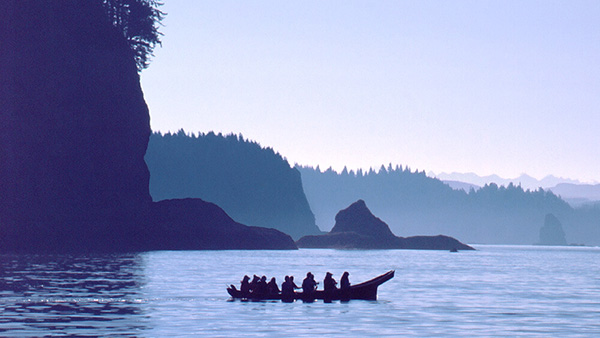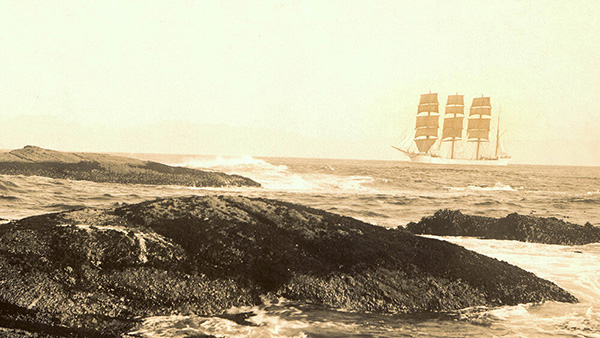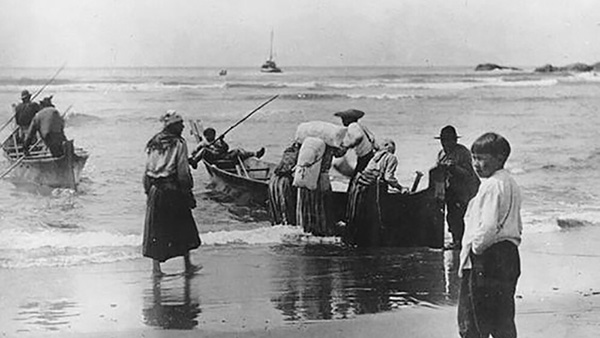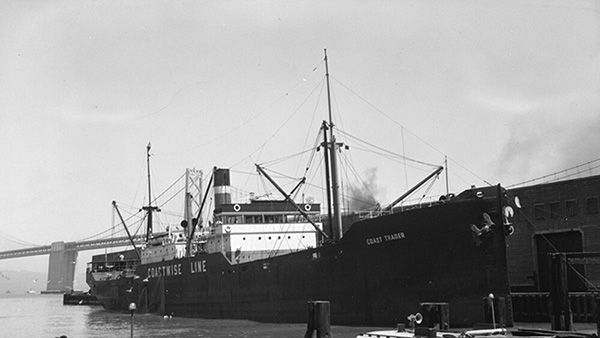Twentieth Century
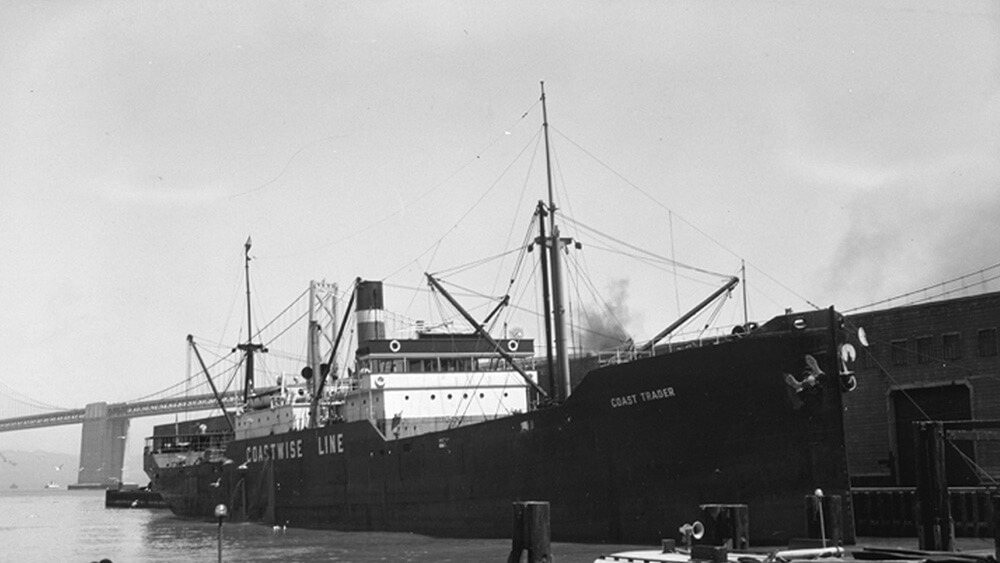
World War II Era
Japanese Submarines (I-Boats) on the Washington Coast
The West Coast of the U.S. became an active Japanese patrol zone from December of 1941 through 1942. Japanese military strategists wanted to keep the U.S. "off balance" following the attack on Pearl Harbor; they correctly deduced that a West Coast submarine threat would tie up a considerable number of U.S. patrol vessels and aircraft that were desperately needed elsewhere.
On June 7, 1942, SS Coast Trader was sailing from Port Angeles, Washington, to San Francisco, California. About 30 miles from the Strait of Juan de Fuca, it was attacked by a Japanese submarine (I-26). Coast Trader managed to launch one lifeboat and two rafts. A nearby fishing vessel, Virginia I, towed the lifeboat to Neah Bay 30 hours after the attack. Ten hours later the Canadian corvette Edmundston (K-106) picked up the rafts carrying nine officers, 28 men, and 19 armed guards, and landed them at Port Angeles. One man died from exposure before being rescued.
On June 20, 1942, another Japanese submarine (I-25) torpedoed and shelled the freighter SS Fort Camosun off Cape Flattery. The crew abandoned ship, but before it sank, it was towed to safety in Neah Bay. The freighter was certainly saved by the crews of the rescuing ships, but also by the fact that its cargo of plywood provided critical buoyancy. No lives were lost. The SS Fort Camosun reached safety in Neah Bay. It was subsequently towed to Esquimalt, British Columbia, then to Victoria, then to Seattle for repairs. It returned to help in the war effort and survived another torpedo in the Gulf of Aden. U.S. destroyers sank the I-25 in 1943.
Cold War Era
1966 Soviet Fishing Fleet
In 1966, a Soviet fishing fleet appeared off the Washington and Oregon coast. At that time, the U.S. territorial sea only extended to three nautical miles offshore. An account from Bob Hitz, a now-retired marine biologist, describes this remarkable sight during a research trip just off the coast of Washington in 1966:
"Everywhere else there were ships, a huge fleet of Russian ships and as the sun rose, the red hammer and sickle on the stacks seemed to glow from the reflection."
This event angered WWII veterans, Washington Democratic U.S. Senator Warren Magnuson and Alaska Republican Senator Ted Stevens. Cold War politics dominated the worldview of Magnuson, a naval veteran during World War II, who bristled at the sight of Soviet catcher-processors just off the picturesque coastline of Washington and Oregon. Thousands of foreign boats plundered haddock and other fish stocks off New England as well, and Japanese trawlers clustered year-round in Alaska waters. But it was the industrial-scale Soviet fleet off the Pacific Northwest that especially bothered Magnuson.
Magnuson and Stevens agreed it was time for the United States to establish a 200-mile exclusive fisheries zone off the coastlines, and in 1976 an ocean fishery management law, today known as the Magnuson-Stevens Fishery Conservation and Management Act, was passed.
1969 Amchitka Nuclear Testing
The Aleutian island of Amchitka was selected by the U.S. Atomic Energy Commission to be the site for underground detonations of nuclear weapons. Three such tests were carried out: Long Shot, an 80-kiloton blast in 1965; Milrow, a 1-megaton blast in 1969; and Cannikin in 1971—at 5 megatons, the largest underground test ever conducted by the United States. These tests were highly controversial—environmental groups feared that the Cannikin explosion, in particular, would cause severe earthquakes and tsunamis. Amchitka is no longer used for nuclear testing, though it is still monitored for the leakage of radioactive materials. As part of mitigation from the nuclear tests, 59 sea otters were captured and translocated to multiple locations including the Olympic Coast.
United States Versus Washington
In the 1970s, Native American tribes in the state of Washington sought to have greater access to their treaty resources and uphold their treaty rights in federal court. The outcome of this arduous legal path re-established these treaties as the supreme law of the land and culminated in the seminal case of United States v. Washington, written by Judge George Boldt and often referred to as the “Boldt decision”. In arriving at the decision upholding the treaty rights, Judge Boldt traced the history of the salmon fishing tribes of the state of Washington to treaty-time signing periods. Judge Boldt’s decision recounts:
“From the earliest known times, up to and beyond the time of the Stevens’ treaties, the Indians comprising each of the treating tribes and bands were primarily a fishing, hunting, and gathering people dependent almost entirely upon the natural animal and vegetative resources of the region for their subsistence and culture. . . .
The treaty-secured rights to resort to the usual and accustomed places to fish were a part of larger rights possessed by the treating Indians, upon the exercise of which there was not a shadow of impediment, and which were not much less necessary to their existence than the atmosphere they breathed. The treaty was not a grant of rights to the treating Indians, but a grant of rights from them, and a reservation of those not granted.” U.S. v. Washington 384 F. Supp. 406-407.
The treaty right to fish is constrained only by the requirement to ensure fishery resources are preserved and maintained. Additionally, Executive Order 13175 requires the sanctuary to consult with the tribes, in a timely manner, if a proposed regulation might adversely impact them.
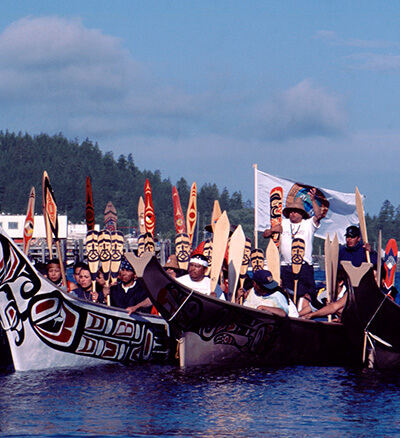
Tribal Journeys
Pacific Northwest tribes were renowned for their seamanship and skill in making canoes. These sea-worthy vessels, crafted from a single red cedar log, were a major part of their culture. Over time as tribal people adopted newer technologies, the building and use of the traditional canoes had almost disappeared. The 1989 “Paddle to Seattle” was the beginning of a revival of traditional tribal maritime heritage. Since that first tribal canoe journey, it has become an almost annual event involving tribes from the United States and Canada. Sometimes, Indigenous people from further away will participate with their traditional craft. The first 1989 event started from La Push on the Quileute Reservation. The Coastal Treaty Tribes in Washington have hosted four of the journeys, 1997 Paddle to La Push, 2002 Paddle to Quinault, 2010 Paddle to Makah, and 2013 Paddle to Quinault.
Makah Whale Hunt
The Makah Tribe has always had a special connection to the ocean, and whaling plays a central part of their identity and culture. During treaty negotiations, Governor Isaac Stevens noted that, “the great father knows what whalers you are—how you go far to sea to take whale.” As a result of the Treaty of Neah Bay, the Makah secured their continued right to whale. While this was a recognized treaty right, commercial whaling decimated whale populations, leading the Makah to give up whaling in 1928. During the sanctuary designation process, the Makah made it clear to NOAA that when the gray whale was delisted from the endangered species list, they would seek to resume exercising their treaty right.


